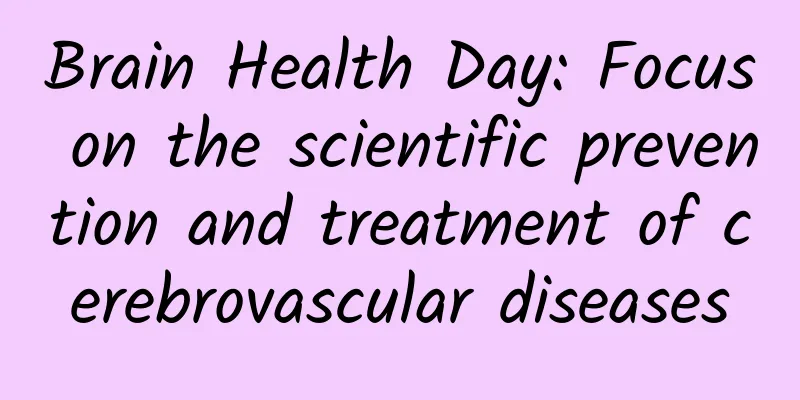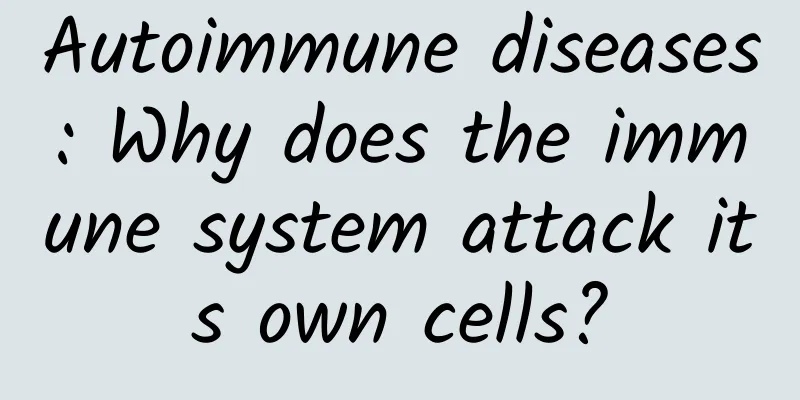Brain Health Day: Focus on the scientific prevention and treatment of cerebrovascular diseases

|
Since 2000, when Wang Zhongcheng and more than 100 famous experts and scholars from the Brain Health Professional Committee of the Chinese Medical Promotion Association proposed to designate September 16th of each year as "Brain Health Day", China Brain Health Day has been held for 21 years. With the continuous development of Brain Health Day activities, people's awareness of brain health has gradually increased. Indeed, the brain is the headquarters of the entire human body, commanding and controlling all life activities of the body. Brain health is crucial to human health. Cerebrovascular disease is an important factor that endangers brain health and has even become the leading cause of death among Chinese residents. Scientifically preventing and treating cerebrovascular diseases is an important part of ensuring brain health. Classification of cerebrovascular diseases In terms of the consequences caused by the disease, cerebrovascular disease can be broadly divided into two categories: ischemic cerebrovascular disease and hemorrhagic cerebrovascular disease. Specifically, the diseases involved in ischemic cerebrovascular disease include moyamoya disease, carotid artery stenosis, vertebral artery stenosis, subclavian artery stenosis, cerebral vascular stenosis, etc., and the diseases involved in hemorrhagic cerebrovascular disease include moyamoya disease, cerebral aneurysm, cerebral vascular malformation, cerebral arteriovenous fistula, etc. Moyamoya disease is mentioned in both ischemic and hemorrhagic cerebrovascular diseases. Moyamoya disease is a special and uncommon cerebrovascular disease. It is caused by chronic progressive stenosis or occlusion of the main cerebral arteries, followed by compensatory proliferation of the perforating arterial network at the base of the skull, forming a smoke-like abnormal vascular network, so it is called moyamoya disease. The stenosis or occlusion of the main cerebral arteries will affect cerebral blood flow, and the smoke-like blood vessels that proliferate at the base of the skull are very fragile and easy to rupture, so moyamoya disease can cause both cerebral ischemia and cerebral hemorrhage. Therefore, moyamoya disease is also an important factor threatening brain health and should be given sufficient attention. The dangers of cerebrovascular disease The hazards of cerebrovascular disease are similar to the classification of cerebrovascular disease. The most important ones are ischemic hazards and hemorrhagic hazards: Ischemic hazards can be divided into mild and severe types. There are transient ischemic attacks, which can manifest as transient limb weakness and numbness, visual field loss, diplopia, monocular blindness, slurred speech, swallowing disorders, coughing when drinking water, etc., which fully recover within 24 hours without sequelae; reversible ischemic neurological dysfunction, which is a localized neurological dysfunction that lasts for more than 24 hours (the boundary with TIA), but fully recovers within 3 weeks. Neurological examinations can reveal positive focal neurological deficit signs, and there may be small cerebral infarction foci; complete ischemic stroke, which is generally irreversible, and can lead to crooked mouth and eyes, visual impairment, aphasia, limb movement disorders, hemiplegia, etc., with a high disability and mortality rate. The harm of hemorrhagic diseases can be mild or severe. Generally, the greater the amount of bleeding, the greater the damage to the brain and the more serious the harm. According to the location of bleeding, it can be divided into subarachnoid hemorrhage, ventricular hemorrhage, brain parenchymal hemorrhage, brain stem hemorrhage, etc., which can cause dizziness, headache, nausea and vomiting, impaired consciousness, movement disorders (limb hemiplegia), language disorders, etc., and the disability and mortality rate is very high. Among them, brain stem hemorrhage has the highest mortality rate and the worst prognosis. Treatment of cerebrovascular disease The treatment of cerebrovascular disease is generally divided into medical treatment and surgical treatment, which are divided and treated according to the corresponding indications. Medical treatment has a complete set of treatment and medication principles, and here we focus on the surgical treatment of various cerebrovascular diseases. Moyamoya disease: Currently, combined vascular bypass surgery is an effective means of treating moyamoya disease. This is a composite procedure of direct bypass and multi-factor patching. While direct bypass quickly improves local blood supply to the brain, multi-factor patching is performed on the brain surface to form new blood vessels in a larger area, expand the scope of blood supply improvement, and rebuild a complete blood bypass system for the patient's brain, with ideal results. Carotid artery stenosis: For moderate to severe carotid artery stenosis, carotid endarterectomy should be given priority for those who meet surgical indications. Carotid endarterectomy removes atherosclerotic plaques under direct vision, making the inner wall of the carotid artery smooth, restoring the inner diameter to normal size, and reconstructing normal lumen and blood flow. It has a very good clinical effect and has become the first choice for the treatment of carotid artery stenosis. Cerebral vascular stenosis: For patients with carotid artery stenosis who cannot tolerate carotid endarterectomy, as well as patients with subclavian artery stenosis, vertebral artery stenosis or intracranial vascular stenosis, neurointerventional treatment can be considered. A balloon microcatheter is introduced into the stenosis for dilation or a special metal stent is placed into the stenotic blood vessel for dilation, thereby achieving the purpose of restoring antegrade blood flow. Brain aneurysm: Aneurysm embolization uses microcatheter technology to deliver embolic materials into the aneurysm cavity, and uses coils or other embolic materials to fill the aneurysm, causing the aneurysm to thrombose and achieve the purpose of treatment. For patients who cannot be treated with embolization, craniotomy and aneurysm clipping can be performed. Cerebrovascular malformations, cerebral arteriovenous fistulas, etc.: minimally invasive interventional embolization treatment is feasible. For patients who have already suffered from cerebral infarction or cerebral hemorrhage, they need to undergo acute treatment first, and then treat the primary disease after their condition stabilizes: the treatment of acute cerebral infarction is divided into intravenous thrombolysis, arterial thrombolysis, mechanical thrombectomy, angioplasty and other treatments; personalized minimally invasive surgical treatment of acute cerebral hemorrhage can formulate personalized treatment plans based on the bleeding time, bleeding site, bleeding amount and the patient's basic condition. Specific surgical methods include minimally invasive keyhole approach intracerebral hematoma removal, minimally invasive hard channel or soft channel hematoma removal, hematoma removal surgery under stereotactic navigation, endoscopic hematoma removal surgery, etc. Prevention of cerebrovascular disease Congenital cerebrovascular disease may not be prevented, and patients need active treatment. Most cerebrovascular diseases may be related to bad lifestyles and eating habits, so we should strengthen prevention in this regard. In simple terms, it mainly includes: maintaining a reasonable diet, balanced nutrition, moderate exercise, a happy mood, etc. Eat more vegetables and fruits, supplement dietary fiber, eat less greasy, spicy, and irritating food. Control weight, avoid obesity, strictly control blood pressure, blood sugar, blood lipid levels, quit smoking and limit alcohol, etc. |
>>: Potential risks of the new coronavirus vaccine: How terrible is the ADE effect?
Recommend
Warning! These common hormone therapies may increase breast cancer risk
Breast cancer is one of the most common malignant...
Huaxi doctors warn you to be careful when eating crabs! Especially this may be life-threatening
"How dare you eat crabs? A few years ago I s...
Signs and precautions of women's premenopause
Menopause is something every woman goes through. ...
What is the cause of abdominal distension and pain and increased leucorrhea?
A large number of female friends have reported th...
What is the effect of Fuyanxiao Capsule
What is the effect (efficacy) of Fuyanxiao Capsul...
Will my belly get bigger when I'm pregnant?
The symptoms of early pregnancy are determined by...
Can pregnant women eat leeks in the early stages?
When many pregnant women are pregnant, their fami...
Nursing methods for pain on the right side of the uterus
Nowadays, people’s quality of life is getting bet...
What causes vomiting during menstruation?
Some adolescent women often experience periodic r...
Why are women not interested in sex?
As we all know, for many people in life, the most...
What should I do if I get enteritis during pregnancy?
Enteritis is actually not a serious disease and c...
Pregnant women fish recipes
Fish is a food with great nutritional value. Eati...
When do tourist buses usually arrive at Mount Emei and where do you board the bus?
Mount Emei is a famous Buddhist mountain in Sichu...
Can I eat spirulina during menstruation?
I believe that for many female friends, there are...
What gynecological examinations should be done before pregnancy
Before preparing for pregnancy, both husband and ...









